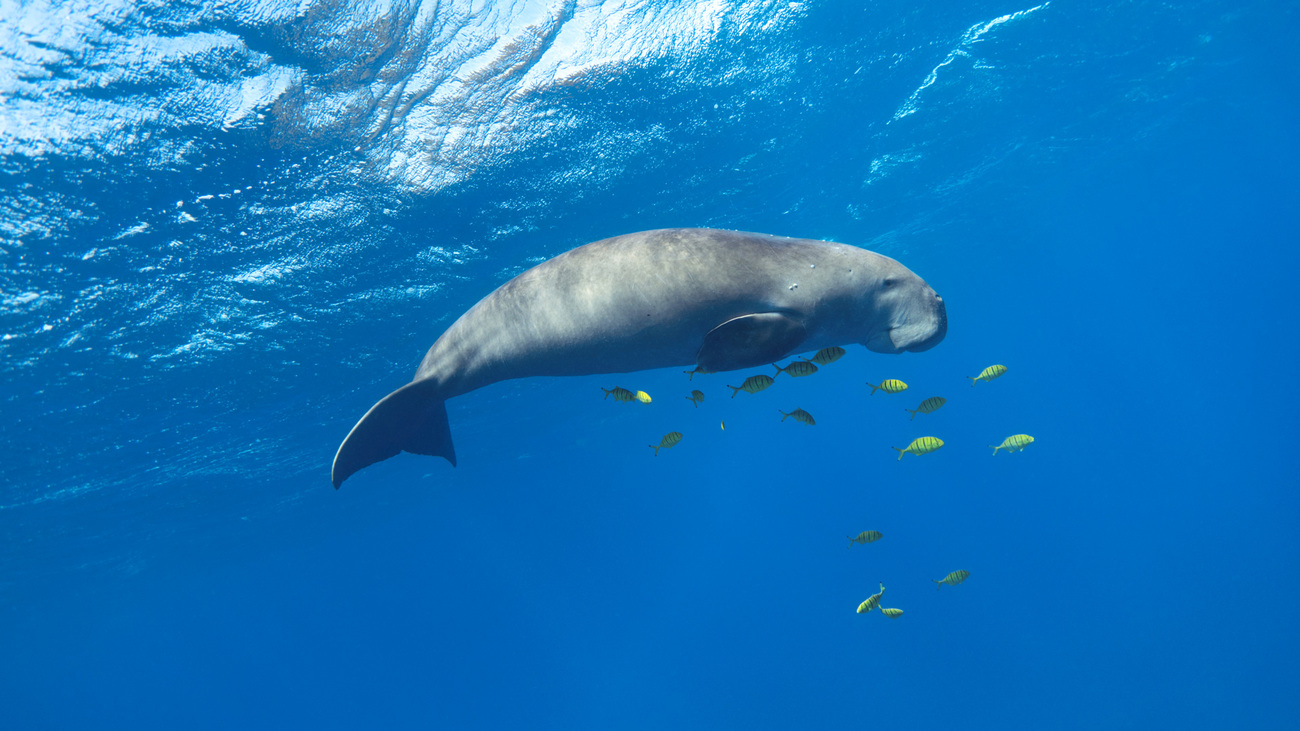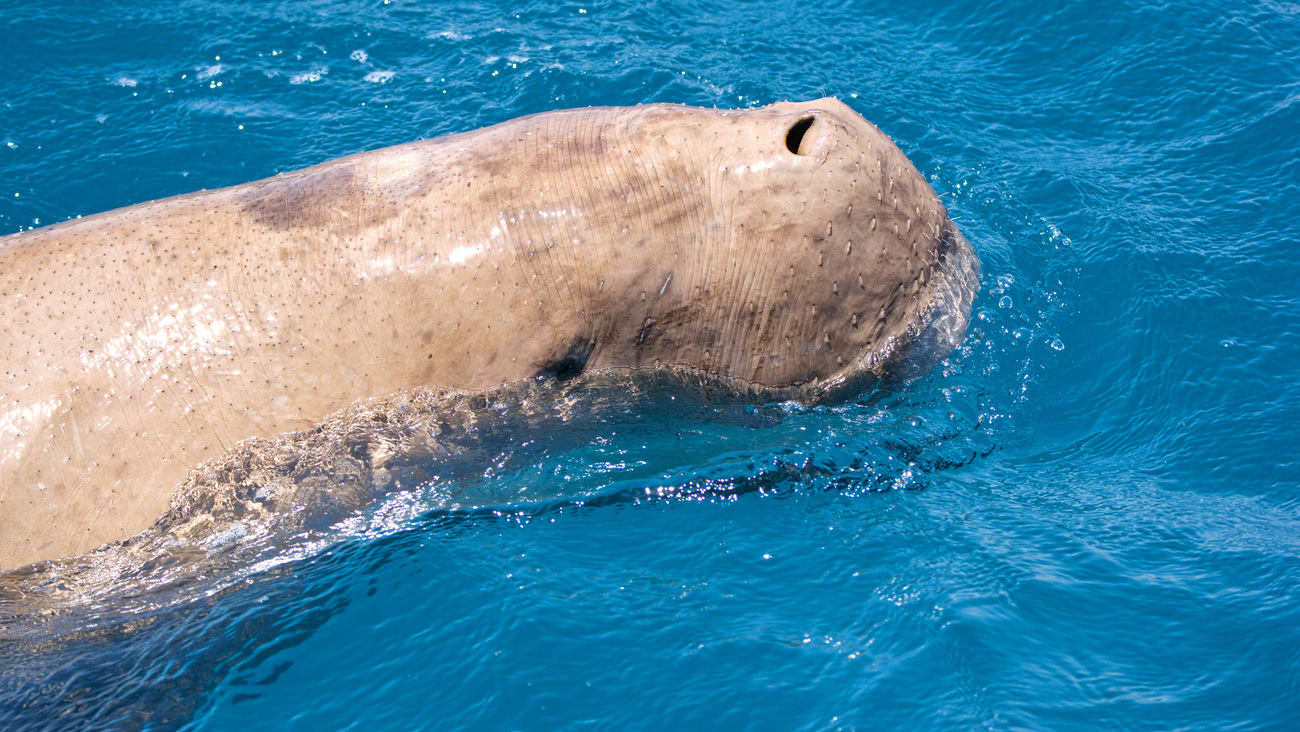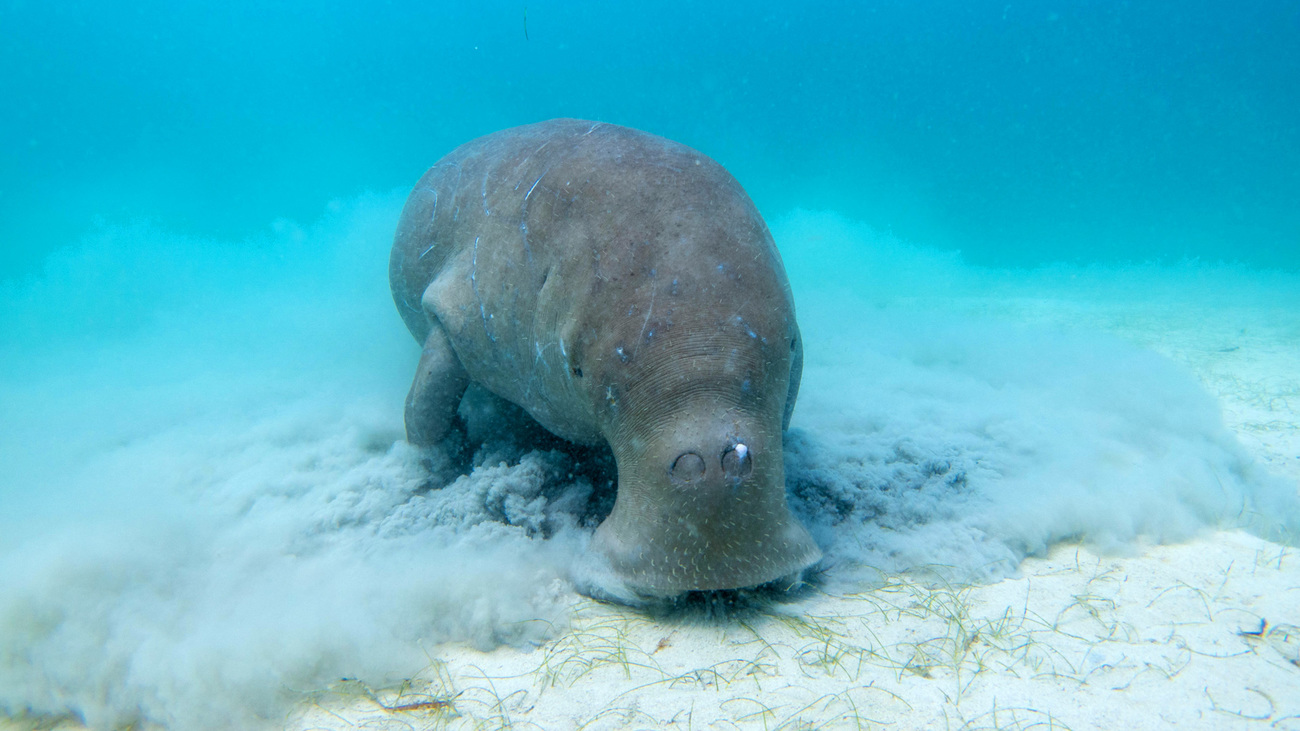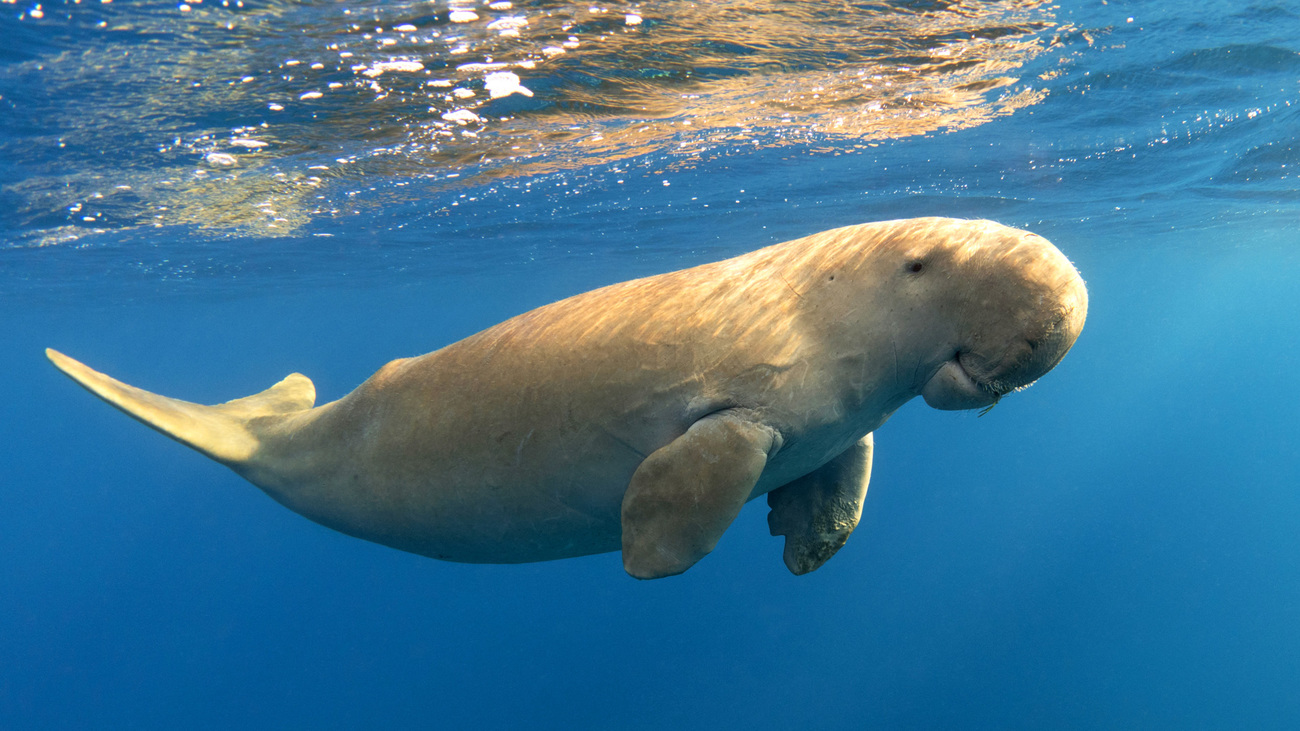Dugongs
Dugongs are large marine mammals often called sea cows due to their herbivorous diet and slow, gentle nature. They are related to both manatees and—surprisingly—elephants. They live in warm coastal waters from East Africa to Australia, grazing on underwater grasses as their main food source.
They share many physical characteristics with manatees, including a streamlined body with a rounded, blubbery shape, a broad tail fluke, and paddle-like flippers. They are typically grey or brown and can grow to lengths of up to three metres and weigh as much as 400 kilograms.
Dugongs are believed to be the original inspiration for ancient seafaring tales of mermaids and sirens.
Dugongs play a crucial role in their ecosystems by acting as ‘ecosystem engineers’. Their feeding behaviours help maintain the health of seagrass beds by controlling the growth of the plants. This, in turn, benefits a wide variety of marine species that depend on seagrass habitats for food and shelter.
Additionally, seagrass meadows are highly effective at capturing and storing carbon. As climate change affects oceans across the globe, dugongs help maintain the plants that sequester carbon and contribute to the overall health of the planet.
Dugongs also provide a food source for predators like sharks and killer whales, contributing to the stability of the marine food web. Unfortunately, dugongs are listed as vulnerable or endangered in many parts of their range due to various threats, including habitat loss, pollution, entanglement in fishing nets, and boat strikes.
Dugongs hold cultural significance for many indigenous communities in regions where they are found. For some Aboriginal Australians, hunting dugongs is integral to maintaining familial connections and social structure while also providing a necessary food source in places where fresh food is expensive and difficult to obtain.
These creatures feature prominently in the art and stories of many coastal peoples across the globe, so the conservation of dugong populations is important for both environmental and cultural reasons.
What is a dugong’s scientific name?
The scientific name for the dugong is Dugong dugon. They are the only living member of the family Dugongidae, its closest relative having been hunted to extinction in the 1700s.
The word ‘dugong’ comes from the word ‘dugung’ in Cebuano, an Austronesian language of the central Philippines.
Are dugongs endangered?
Dugongs are listed as vulnerable on the IUCN Red List and have been considered so since 1982. The current global population of dugongs is in decline due to human interactions with the species.
The dugong’s closest modern relative, Stellar’s sea cow (Hydrodamalis gigas), was hunted to extinction in the 18th century, and without proper protections, dugongs could face the same fate.
There are still approximately 100,000 dugongs living in the waters of around 40 countries. But because they have such a broad range, different populations of dugongs are more critically threatened than others. For example, dugongs are considered functionally extinct in Chinese waters, while they are particularly abundant off the coast of northwestern Australia.
Where do dugongs live?
Dugongs live in warm coastal waters of the Indian and Pacific oceans with the largest populations living off the coast of western and northern Australia. Unlike manatees, which can be found in freshwater, dugongs only live in saltwater.
Seagrass meadows, extensive underwater areas dominated by various species of seagrasses, serve as their primary feeding areas. These meadows are typically found in calm, shallow waters, estuaries, lagoons, and inlets.
The largest population of dugongs live off the coast of Australia, in the warm Indian Ocean. Dugongs also can be found off the western coast of Madagascar, along the east coast of Africa, in the Red Sea and the Persian Gulf, around the Indian subcontinent, and in the western Pacific from southern Japan to northern Australia.
Dugongs are highly dependent on the presence and health of seagrass habitats within these coastal and nearshore areas.
Threats
The threats to dugongs vary between specific areas and populations, but in general, they include habitat loss and degradation due to coastal development, pollution, and the destruction of seagrass meadows. Fishing and shipping also present serious threats to this species.

Fishing
Dugongs can easily get tangled in gillnets or caught in traps set for other species, making them unintentional victims of fishing operations. Also, the overfishing of fish species that graze on seagrasses can indirectly harm dugongs by disrupting the balance of the ecosystem. Bottom trawling also damages seagrass meadows, threatening dugongs’ primary food source.
Vessel strikes and noise pollution
Boating activities cause several problems for a wide range of marine species, including dugongs. Dugongs are vulnerable to collisions with boats and watercraft because they are slow-moving and tend to float near the water’s surface.
Boat engines also create underwater noise pollution in dugong habitats. Noise pollution can interfere with their communication, navigation, and foraging, potentially leading to disorientation and stress.
Excessive boat activity can degrade seagrass meadows and interrupt dugong feeding and breeding cycles.
Habitat loss
Dugongs face the threat of habitat loss from many causes, including human settlement on coasts, shipping, trawling and destructive fishing, and natural disasters like cyclones and tsunamis.
Threats to their food source
Dugongs rely on seagrass to survive, and the degradation of their feeding ground directly leads to their decreasing population. Seagrass is constantly threatened by untreated sewage disposal, coastal dredging, agricultural pollution, and fishing practices.
Climate change
Just like most other animal species on the planet, dugongs face the looming threat of climate change. Extreme weather events and rising temperatures are constantly contributing to the declining health of dugong populations.
Hunting
Even though dugongs are legally protected in most regions, they are still hunted for their meat and oil. In some Asian cultures, dugong meat is considered luxury food and is also believed to have aphrodisiac properties, and they have been hunted to near-extinction in some countries, including Indonesia, Singapore, and Cambodia.
While dugong hunting is illegal in most places, in Australia it is legal but heavily regulated. Conservationists are pushing for the number of dugongs hunted in Australia to be drastically reduced.
FAQs
Are dugongs manatees?
While dugongs are related to manatees, they are two different species.
Here’s how to tell them apart:
- Dugongs have a notched tail like a whale’s, while manatees have a round tail.
- Dugongs have broad, trunk-like snouts, while manatees have short snouts with a divided upper lip.
- Dugongs never leave saltwater, while manatees can also live in freshwater habitats.

How many dugongs are left?
As of August 2022, there were thought to be around 100,000 dugongs left worldwide.
The size of dugong populations varies wildly by region. In one area off the coast of Western Australia, called Shark Bay, there are about 10,000 dugongs. Another 20,000 live in the Gulf of Carpentaria, off Australia’s northern coast.
However, in other areas, dugong populations are dwindling. They are functionally extinct in Chinese waters, quickly dwindling in Thailand, and there are fewer than 50 left in Okinawa, Japan.
What country do dugongs live in?
Dugongs can be found in the coastal waters of around 40 countries in the Indian and Pacific oceans. The waters of Australia are home to the most significant dugong populations.
They also live along the coasts of countries bordering the Red Sea, including Egypt and Sudan, and all the coastal areas of the Indian Ocean, including the Maldives, Sri Lanka, and the eastern coast of Africa.
The western, warmer Pacific Ocean is also a dugong habitat, including areas around countries such as Indonesia, the Philippines, and the Solomon Islands. In Southeast Asia, some populations exist in regions such as the Andaman Sea and the Gulf of Thailand.
Dugong distribution is closely tied to the presence of seagrass habitats, which are their primary food source. The health of these habitats plays a significant role in their presence in a particular area.
Are dugongs friendly?
Dugongs are very friendly, curious animals and often interact with people. However, as with all wild animals, you should always be cautious when viewing dugongs. Always keep your distance from mothers with calves, and never interrupt them while they’re eating.
Dugongs are intelligent animals with long memories. Disturbing a dugong while it feeds can lead to them not eating enough, impacting the number of calves born.
Do sharks eat dugongs?
In most cases, dugongs can evade sharks due to their large size and ability to swim quickly. Though it is rare, tiger sharks have been known to attack and feed on dugongs.
Dugongs can become targets if isolated or weakened, making them more vulnerable to attacks by larger marine animals.
How long do dugongs live?
Dugongs live long lives—up to 73 years. Females reach sexual maturity at age 10. They give birth every three to seven years and have a 12-month gestation period.
Do dugongs have teeth?
Yes, dugongs have teeth. Their teeth and skulls are one way in which they’re different from manatees. As herbivores, their teeth are peglike, adapted for grinding rather than cutting or tearing.
Dugongs’ front incisor teeth form short tusks, which are most clearly visible on adult males. These signal to females that the male has reached maturity and is ready to breed.
How long can dugongs stay underwater?
As mammals, dugongs breathe oxygen the same way humans do. A dugong can typically stay underwater for around six minutes before it needs to resurface for air. Dugongs can extend their time underwater when resting or sleeping, as they can reduce their metabolic rate during these periods.
In shallow water, they sometimes breathe by ‘standing’ on their tails and putting their heads above the water’s surface.
Our work
IFAW is focused on helping marine mammals across the globe, including dugongs. IFAW’s Marine Conservation program in Kenya recently helped conduct an aerial survey to map out the population of dugongs off the country’s coast. In the 1960s, hundreds of dugongs were spotted in this area, but—alarmingly—in 2023, we only found two.
The survey also aimed to identify and map out threats to dugong survival to boost our conservation efforts for these populations. With the right data, we can help develop appropriate management strategies to reduce threats to dugongs and get their population back to healthy numbers.
IFAW is also dedicated to reducing ocean noise pollution across the globe. Dugongs rely on vocalisations to communicate with one another, and so underwater noise interferes with their ability to attract mates, communicate with their young, and even feed—so this push to reduce ocean noise pollution is necessary to help maintain healthy dugong communities.

How can you help?
Dugong populations are declining around the world. IFAW’s marine conservation projects are helping marine mammals like dugongs, whales, and dolphins.
